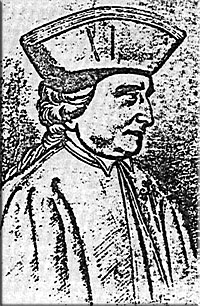
Jose de Escandon. From 1748 to 1755, the Spanish expedition leader settled more than 20 towns and villages along the Rio Grande and other areas of New Spain, including the colony of Santander. For his efforts, he has been called the "father of the lower Rio Grande Valley. McAllen Library.  |

El Norte Provinces, showing location of
Santander and Texas in the late eighteenth century. Adapted
from map by Jack Jackson, original in State Land Office map
collection.  |
|
The rancho owners' connection to the
town was very important. It was a place to gather supplies,
go to church, and attend festivals, weddings, baptisms, and
other celebrations. |

Longhorns in south Texas. These famed cattle are thought to have originated from Spanish and Mexican stock that ranged north of
the Rio Grande.  |
|
Expedition leader Jose de Escandón handpicked
the locations for the new colonies, consisting of civilian cattle
ranching haciendas (headquarters), villas (towns),
and lugars (settlements). The colonists were drawn from neighboring
provinces and were exempt from taxes for the first 10 years.
Four villas were founded along the Lower Rio Grande, including Camargo (founded March 5, 1749) Reynosa (founded March 14, 1749), and Revilla (founded October 10, 1750) located on the south side of the Rio Grande, and Laredo on the north side of the river (founded May 15, 1755). In addition, on August 22, 1750, Escandón granted José Vázquez Borrego permission to found Nuestra Señora de los Dolores on the north side of the Rio Grande, which soon became more of a small hacienda rather than a villa. One of the settlements established by the expedition was called Mier, founded on March 6, 1753 near the confluence of the Rio Grande and the Rio Alamo; it is now on the Mexican side of the Rio Grande.
Ranchos along the River
Mier was founded to be the central settlement for
a series of ranchos that occupied the land surrounding the town
on both sides of the river. Thirty-eight families were brought up
from Cerralvo, Nuevo Leon, and joined 19 families already in the
area. Each settling family was awarded a porcion, or land
grant, that consisted of a narrow strip of land containing from 0.5 to 1
mile of riverfront property and extending about 14 to 15 miles away
from the Rio Grande.
Families were also given a small plot in town to build
a house, if they wished. Many of the buildings on each porcion were
placed near the Rio Grande, just far enough away to avoid flooding,
and the rest of the land was used for sheep, goats, and cattle.
No fences were used, and the animals could roam as they pleased
across porciones. Cattle belonging to different owners would often
merge together into large herds, and would only be separated during
a rodeo, or roundup. To some extent, this was done as a defensive
measure against Indian raids. To protect the cattle, ranchers allowed
them to roam free, making them a less obvious target.
Cattle-raising in the Eighteenth Century
Cattle-raising operations in southern Texas and Northern
Mexico usually fell into two general categories. The rancho was
a small rural estate that was worked by the owner and his family
who both farmed and raised livestock. They held only a few thousand
acres of land and a few thousand cattle. Their owners were considered
part of the "middle class" of Spanish Colonial society.
Another form of ranching centered on the big hacienda, a large,
rural, self-sufficient estate. Hacienda families were involved in
cattle raising, sheep and goat herding, agriculture, or mining—anything
that could be produced and sold for a profit. The hacienda could
occupy hundreds of thousands of acres and have tens of thousands
of cattle. The patrón, or owner, of the hacienda was
a member of the upper class, enjoying wealth, prestige, and political
influence. His workers, the vaqueros (cowboys), and their
families were members of the lower class, the peón,
and were usually bound by debt to the patrón. Several true
haciendas were in operation in northern Mexico and later in Texas
in the nineteenth century, but no haciendas of that scale were ever located along
the Rio Grande, only small haciendas or ranchos.
The ranching families maintained a strong connection
to the town. It was a place to gather supplies, go to church, and
attend festivals, weddings, baptisms, and other celebrations. It
was a place where the men could meet with the other ranchers in
the community, discuss political and social issues, and plan out
the next rodeo.
|
|